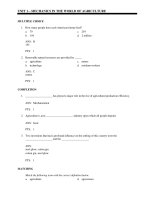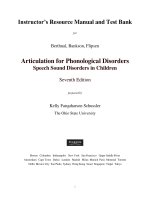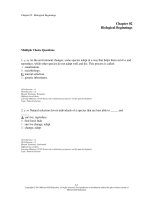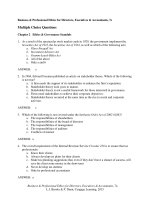Employee training and development 7th edition noe test bank
Bạn đang xem bản rút gọn của tài liệu. Xem và tải ngay bản đầy đủ của tài liệu tại đây (67.5 KB, 21 trang )
Page 1
Chapter Two
Strategic Training
OBJECTIVES
1.
Discuss how business strategy influences the type and amount of training in a company.
2.
Describe the strategic training and development process.
3.
Discuss how a company’s staffing and human resource planning strategies influence training.
4.
Explain the training needs created by concentration, internal growth, external growth, and
disinvestment business strategies.
5.
Discuss the advantages and disadvantages of centralizing the training function.
6.
Explain a corporate university and its benefits.
7.
Discuss the strengths of a business-embedded learning function.
8.
Discuss how to create a learning or training brand and why it is important.
9.
Develop a marketing campaign for a training course or program.
MULTIPLE CHOICE
2.1.
Which of the following is true about a learning organization?
a.
A learning organization discourages learning at the group and organizational levels.
b. A learning organization restricts employees from experimenting with products and services.
c.
In a learning organization, employees learn from failure and from successes.
d. In a learning organization, employees are discouraged from asking questions and admitting
mistakes.
Answer: c
Difficulty: easy
Learning objective: 1
2.2.
The strategic training and development process begins with _____.
a.
choosing strategic training and development initiatives
b. identifying the business strategy
Copyright © 2017 McGraw-Hill Education. All rights reserved. No reproduction or distribution without the prior written consent of
McGraw-Hill Education.
Page 2
c.
developing websites for knowledge sharing
d. identifying measures or metrics
Answer: b
Difficulty: easy
Learning objective: 2
2.3.
The final step of the strategic training and development process involves _____.
a.
choosing strategic training and development initiatives
b. identifying the business strategy
c.
identifying measures or metrics
d. creating concrete training and development activities
Answer: c
Difficulty: easy
Learning objective: 2
2.4
_____ typically includes information on the customers served, why the company exists, what the
company does, the value received by the customers, and the technology used.
a.
Balanced scorecard
b. Vision
c.
Mission
d. Code of conduct
Answer: c
Difficulty: easy
Learning objective: 2
2.5.
Which of the following is not one of the four major components of the balanced scorecard?
a.
Customers
b. Internal business processes
c.
Sustainability
d. Financial
Copyright © 2017 McGraw-Hill Education. All rights reserved. No reproduction or distribution without the prior written consent of
McGraw-Hill Education.
Page 3
Answer: c
Difficulty: medium
Learning objective: 2
2.6.
A SWOT analysis is typically conducted in the _____ step of the strategic training and development
process.
a.
business strategy formulation and identification
b. strategic training and development initiatives
c.
training and development activities
d. measures or metrics identification
Answer: a
Difficulty: easy
Learning objective: 2
2.7.
_____ involves examining a company’s operating environment to identify opportunities and threats.
a.
Internal analysis
b. Gap analysis
c.
External analysis
d. Pareto analysis
Answer: c
Difficulty: easy
Learning objective: 2
Copyright © 2017 McGraw-Hill Education. All rights reserved. No reproduction or distribution without the prior written consent of
McGraw-Hill Education.
Page 4
2.8.
Which of the following is true with regard to SWOT analysis?
a.
In a SWOT analysis, external analysis attempts to identify the company’s strengths and
weaknesses.
b. A SWOT analysis represents the strategy believed to be the best alternative to achieve the
company goals.
c.
A SWOT analysis is typically conducted in the strategic training and development initiatives
step of the strategic training and development process.
d. A SWOT analysis provides a company the information needed to generate several alternative
business strategies and make a strategic choice.
Answer: d
Difficulty: medium
Learning objective: 2
2.9.
Business-level outcomes chosen to measure the overall value of training or learning initiatives are
referred to as _____.
a.
values
b. goals
c.
business strategies
d. metrics
Answer: d
Difficulty: easy
Learning objective: 2
2.10.
The _____ considers four different perspectives: customer, internal, innovation and learning, and
financial.
a.
SWOT analysis
b. value chain analysis
c.
BCG matrix
d. balanced scorecard
Answer: d
Copyright © 2017 McGraw-Hill Education. All rights reserved. No reproduction or distribution without the prior written consent of
McGraw-Hill Education.
Page 5
Difficulty: easy
Learning objective: 2
2.11.
_____ refers to the company’s decisions regarding where to find employees, how to select them,
and the desired mix of employee skills and statuses.
a.
Concentration strategy
b. Staffing strategy
c.
External growth strategy
d. Disinvestment strategy
Answer: b
Difficulty: easy
Learning objective: 3
Copyright © 2017 McGraw-Hill Education. All rights reserved. No reproduction or distribution without the prior written consent of
McGraw-Hill Education.
Page 6
2.12.
Which of the following is not one of the major business strategies discussed in the text?
a.
Internal growth
b. External growth
c.
Divestment
d. Product differentiation
Answer: d
Difficulty: medium
Learning objective: 4
2.13.
Companies that emphasize innovation and creativity are labeled as _____.
a.
clubs
b. academies
c.
fortresses
d. baseball teams
Answer: d
Difficulty: easy
Learning objective: 3
2.14.
In _____ financial and other resources are not available for development, so companies tend to rely
on hiring talent from the external labor market.
a.
clubs
b. fortresses
c.
baseball teams
d. academies
Answer: b
Difficulty: easy
Learning objective: 3
2.15.
Uniqueness refers to _____.
a.
employee potential to improve company effectiveness and efficiency
b. the extent to which training and learning is centralized in an organization
Copyright © 2017 McGraw-Hill Education. All rights reserved. No reproduction or distribution without the prior written consent of
McGraw-Hill Education.
Page 7
c.
the extent to which employees are rare, specialized, and not highly available in the labor
market
d. the picture of the future an organization wants to achieve
Answer: c
Difficulty: medium
Learning objective: 3
2.16.
Job-based employees are characterized by _____.
a.
high value and high uniqueness
b. high value and low uniqueness
c.
low value and low uniqueness
d. low value and high uniqueness
Answer: b
Difficulty: easy
Learning objective: 3
2.17.
Which of the following positions is characterized by high value and low uniqueness?
a.
Lab technician
b. Scientist
c.
Secretarial staff
d. Legal adviser
Answer: a
Difficulty: medium
Learning objective: 3
2.18.
Companies adopting a _____ strategy need to train employees in job-search skills and to focus on
cross-training their remaining employees.
a.
concentration
b. disinvestment
c.
external growth
d. internal growth
Copyright © 2017 McGraw-Hill Education. All rights reserved. No reproduction or distribution without the prior written consent of
McGraw-Hill Education.
Page 8
Answer: b
Difficulty: easy
Learning objective: 4
2.19.
A(n) _____ strategy focuses on new market and product development, innovation, and joint
ventures.
a.
disinvestment
b. privatization
c.
external growth
d. internal growth
Answer: d
Difficulty: easy
Learning objective: 4
2.20.
Development of an organizational culture that values creative thinking and analysis is characteristic
of a company adopting a(n) _____ strategy.
a.
concentration
b. disinvestment
c.
internal growth
d. external growth
Answer: c
Difficulty: easy
Learning objective: 4
Copyright © 2017 McGraw-Hill Education. All rights reserved. No reproduction or distribution without the prior written consent of
McGraw-Hill Education.
Page 9
2.21.
Which of the following is true of centralized training?
a.
A centralized training function helps drive stronger alignment with business strategy.
b. Training and development programs, resources, and professionals are housed in a number of
different locations.
c.
A centralized training function hinders the development of a common set of metrics or
scorecards.
d. A centralized training function is largely ineffective during times of change.
Answer: a
Difficulty: medium
Learning objective: 5
2.22.
Which of the following is true of the business-embedded (BE) learning function?
a.
The BE function is customer-focused.
b. A BE training function views trainees as marketers.
c.
A BE training function does not guarantee that training will improve performance.
d. Training functions organized by the BE model do not involve line managers.
Answer: a
Difficulty: medium
Learning objective: 7
2.23.
Justin Mason, a product manager working in a manufacturing firm, is highly anxious about change.
When the top management of Mason's firm made it mandatory for all product managers to
undergo skills training, he told his superior that he would be uncomfortable with the process. He
added that he was certain of not being able to cope with the new developments. In this instance,
Justin is demonstrating _____.
a.
indifference to change
b. uniqueness
c.
resistance to change
d. loss of control
Answer: c
Copyright © 2017 McGraw-Hill Education. All rights reserved. No reproduction or distribution without the prior written consent of
McGraw-Hill Education.
Page 10
Difficulty: hard
Learning objective:
2.24.
_____ relates to managers’ and employees’ ability to obtain and distribute valuable resources such
as data, information, or money.
a.
Power
b. Control
c.
Vision
d. Outsourcing
Answer: b
Difficulty: easy
Learning objective:
Copyright © 2017 McGraw-Hill Education. All rights reserved. No reproduction or distribution without the prior written consent of
McGraw-Hill Education.
Page 11
2.25.
Which of the following is not one of the major “change-related” problems that need to be
addressed before the implementation of new training practices?
a.
Resistance to change
b. Loss of control
c.
Power imbalance
d. Training-business strategy incongruence
Answer: d
Difficulty: easy
Learning objective:
2.26.
Which of the following is not one of the major reasons organizations outsource training?
a.
Potential cost savings
b. Desire for greater control
c.
Time savings
d. Desire to access best practices
Answer: b
Difficulty: easy
Learning objective:
TRUE-FALSE
2.27.
Learning organizations emphasize that learning occurs not only at the individual employee level
but also at the group and organizational levels.
Answer: true
Difficulty: easy
Learning objective: 1
2.28.
In learning organizations, there is an understanding that failure provides important information.
Answer: true
Copyright © 2017 McGraw-Hill Education. All rights reserved. No reproduction or distribution without the prior written consent of
McGraw-Hill Education.
Page 12
Difficulty: easy
Learning objective: 1
2.29.
Tacit knowledge developed through experience and shared through interactions between
employees is easy to imitate.
Answer: false
Difficulty: easy
Learning objective: 1
2.30.
Explicit knowledge is thought to have a stronger impact on helping organizations achieve a
competitive advantage than tactic knowledge.
Answer: false
Difficulty: medium
Learning objective: 1
2.31.
The first step in the strategic training and development process is to identify metrics to determine
if training will be successful.
Answer: false
Difficulty: easy
Learning objective: 2
2.32.
Internal analysis involves identifying opportunities and threats.
Answer: false
Difficulty: easy
Learning objective: 2
2.33.
Strategic training and development initiatives vary by company depending on a company’s
industry, goals, resources, and capabilities.
Copyright © 2017 McGraw-Hill Education. All rights reserved. No reproduction or distribution without the prior written consent of
McGraw-Hill Education.
Page 13
Answer: true
Difficulty: easy
Learning objective: 2
2.34.
Emphasis on the creation of intellectual capital and the movement toward high-performance work
systems using teams has resulted in employees performing many roles once reserved for
management.
Answer: true
Difficulty: easy
Learning objective: 3
2.35.
From a strategic perspective, “diversify the learning portfolio” refers to providing strategic diversity
training to enhance a company’s competitive advantage.
Answer: false
Difficulty: medium
Learning objective: 2
2.36.
Skill-based pay systems base employees’ pay on what skills they are using for their current jobs
rather than the number of skills they are competent in.
Answer: false
Difficulty: easy
Learning objective: 3
2.37.
The CEO of a company is responsible for setting a clear direction for learning.
Answer: true
Difficulty: easy
Learning objective: 3
Copyright © 2017 McGraw-Hill Education. All rights reserved. No reproduction or distribution without the prior written consent of
McGraw-Hill Education.
Page 14
2.38.
Line managers spend less time managing individual performance and developing employees than
midlevel managers or executives do.
Answer: false
Difficulty: easy
Learning objective: 3
2.39.
In highly integrated businesses, training is likely to include rotating employees between jobs in
different businesses.
Answer: true
Difficulty: easy
Learning objective: 1
2.40.
For companies in an unstable or recessionary business environment, training programs focus more
on correcting skill deficiencies rather than preparing staff for new assignments.
Answer: true
Difficulty: easy
Learning objective: 1
2.41.
Companies that adopt state-of-the-art HRM practices realize higher levels of performance than
firms that do not.
Answer: true
Difficulty: easy
Learning objective: 1
2.42.
Uniqueness refers to employee potential to improve company effectiveness and efficiency.
Answer: false
Difficulty: easy
Copyright © 2017 McGraw-Hill Education. All rights reserved. No reproduction or distribution without the prior written consent of
McGraw-Hill Education.
Page 15
Learning objective: 3
2.43.
Job-based employees are likely to receive less training than knowledge-based employees.
Answer: true
Difficulty: easy
Learning objective: 3
2.44.
Training for contract employees would focus on sharing expertise and team training.
Answer: false
Difficulty: medium
Learning objective: 3
Copyright © 2017 McGraw-Hill Education. All rights reserved. No reproduction or distribution without the prior written consent of
McGraw-Hill Education.
Page 16
2.45.
Companies should generally avoid involving unions in retraining and productivity-improvement
efforts.
Answer: false
Difficulty: easy
Learning objective: 3
2.46.
A centralized training function not only hampers the streamlining of processes but also denies the
company a cost advantage in purchasing training from vendors.
Answer: false
Difficulty: easy
Learning objective: 5
2.47.
Companies pursuing an external growth strategy typically focus on human capital issues to
enhance efficiency.
Answer: false
Difficulty: medium
Learning objective: 4
2.48.
Business process reengineering refers to the outsourcing of any business process, such as HRM,
production, or training.
Answer: false
Difficulty: easy
Learning objective:
2.49.
Outsourcing allows a company to focus better on its business strategy by saving cost and time.
Answer: true
Difficulty: easy
Copyright © 2017 McGraw-Hill Education. All rights reserved. No reproduction or distribution without the prior written consent of
McGraw-Hill Education.
Page 17
Learning objective:
2.50.
Compared to ten years ago, organizations are less focused now on creating a learning and
training brand.
Answer: false
Difficulty: easy
Learning objective: 8
Copyright © 2017 McGraw-Hill Education. All rights reserved. No reproduction or distribution without the prior written consent of
McGraw-Hill Education.
Page 18
SHORT ANSWER-ESSAY
2.51.
Define balanced scorecard. What are the four perspectives it considers? Provide examples of
metrics used to measure them.
The balanced scorecard is a means of performance measurement that provides managers with a
chance to look at the overall company performance or the performance of departments or
functions from the perspective of internal and external customers, employees, and shareholders.
The four perspectives and examples of metrics used to measure them include:
•
Customer (time, quality, performance, service, cost)
•
Internal (processes that influence customer satisfaction)
•
Innovation and learning (operating efficiency, employee satisfaction, continuous improvement)
•
Financial (profitability, growth, shareholder value)
Difficulty: medium
Learning objective: 2
2.52.
Describe the human capital requirements for fortresses, baseball teams, clubs, and academies.
Fortresses—companies with limited resources for training that tend to recruit from the outside
Baseball teams—companies that require innovation and creativity; recruit from other companies or
new graduates with specialized skills
Clubs—companies in highly regulated industries that rely on developing their own talent
Academies—companies that require specialized skill and focus on developing their individual
employees
Difficulty: medium
Learning objective: 3
2.53.
Explain the business-embedded learning function.
Copyright © 2017 McGraw-Hill Education. All rights reserved. No reproduction or distribution without the prior written consent of
McGraw-Hill Education.
Page 19
The BE learning function is characterized by five competencies: strategic direction, product design,
structural versatility, product delivery, and accountability for results. It views trainees, managers,
and senior-level decision makers as customers of training.
The most noticeable feature of a BE learning function is its structure. In BE learning functions all
persons who are involved in the training process communicate and share resources. Trainers—
who are responsible for developing training materials, delivering instruction, and supporting
trainees—work together to ensure that learning occurs. Trainers not only have specialized
competencies, but also can serve as internal consultants by providing a range of services, such as
needs assessment, content improvement, and the like.
Difficulty: medium
Learning objective: 7
2.54.
How does the strategic value of jobs and their uniqueness influence how training and learning
resources are invested?
Uniqueness refers to the extent to which employees are rare, specialized, and not highly available
in the labor market. Strategic value refers to employee potential to improve company effectiveness
and efficiency. These dimensions can be crossed to characterize four types of employees:
Highly valued and unique employees are known as knowledge-based employees. Because
knowledge-based employees possess valuable and unique skills, the company is expected to
invest heavily in training and developing them, especially in developing skills specific to the
company’s needs
Highly valued employees who are not unique are known as job-based employees. Job-based
employees are likely to receive less training than knowledge-based employees because although
they create value for the firm, they are not unique. If they receive training, it would tend to focus
on skills that they need to perform their jobs. Their development opportunities will be limited
unless they have been identified as outstanding performers.
Employees with low value and uniqueness are known as contract employees. The training for
contract workers likely would be limited to ensuring that they comply with company policies and
legal or industry-based licensure and certification requirements.
Copyright © 2017 McGraw-Hill Education. All rights reserved. No reproduction or distribution without the prior written consent of
McGraw-Hill Education.
Page 20
Unique employees with low value are known as alliance/partnership employees. Because they are
not full-time employees of the company but provide valued services, training for
alliance/partnership employees tends to focus on encouraging them to share their knowledge and
using team training and experiential exercises designed to develop their trust and relationships
with job-based and knowledge-based employees.
Difficulty: hard
Learning objective: 3
2.55.
What are the advantages and disadvantages of a centralized training function?
Advantages – (1) ownership of training to one organization; (2) elimination of course and program
variation and duplication; (3) stronger alignment with business strategy; (4) development of a
common set of metrics or scorecards to measure and report rates of quality and delivery; (5)
streamlined processes; (6) cost advantage in purchasing training from vendors and consultants
because of the number of trainees who will be involved; and (7) integration of programs for
developing leaders and managing talent with training during times of change.
The most significant disadvantage is that the training function may not be in touch with the unique
needs of different constituents.
Difficulty: medium
Learning objective: 5
Copyright © 2017 McGraw-Hill Education. All rights reserved. No reproduction or distribution without the prior written consent of
McGraw-Hill Education.
Page 21
2.56.
Describe five strategies for marketing training to internal customers
•
Involving the target audience in developing the training or learning effort
•
Demonstrating how a training and development program can be used to solve specific
business needs
•
Showing an example of how training has been successfully used to solve specific business
needs in the past
•
Identifying a “champion” who actively supports training
•
Listening and acting on feedback received from clients, managers, and employees
•
Advertising on e-mail, on company Web sites, and in employee break areas
•
Designating someone in the training function as an account representative who will interact
between the training designer and the “customer”
•
Determining what financial metrics top-level executives are concerned with and showing how
training will help improve these
•
Speaking in terms that employees understand--avoid technical jargon
Difficulty: medium
Learning objective: 9
Copyright © 2017 McGraw-Hill Education. All rights reserved. No reproduction or distribution without the prior written consent of
McGraw-Hill Education.









